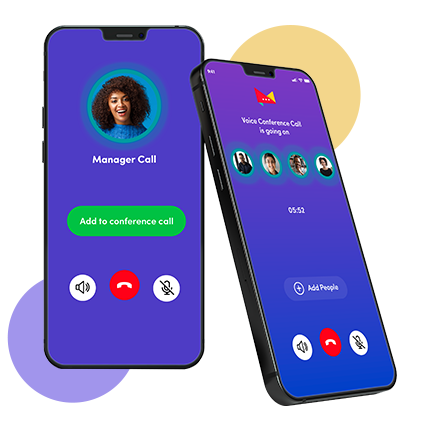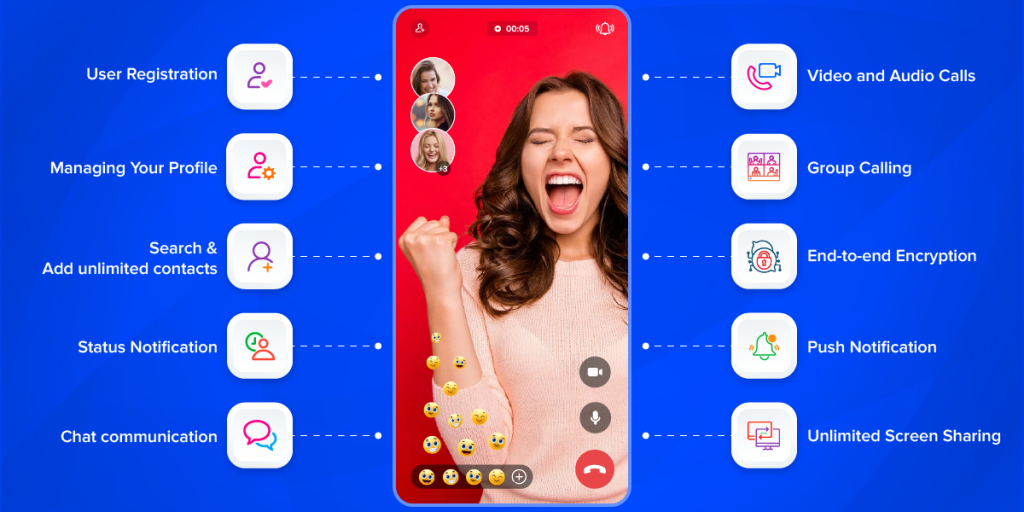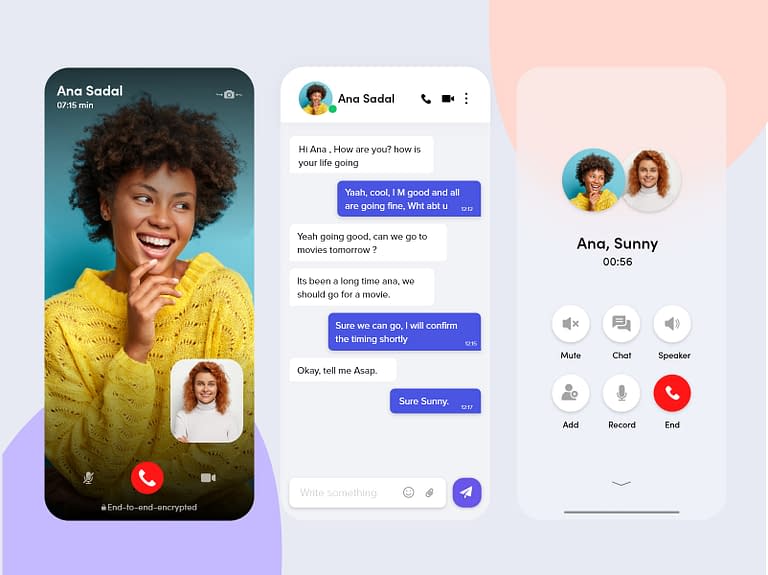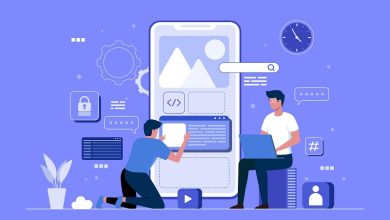5 Things To know Building Own Instant Messaging Platform

Messaging apps have redefined our communication mode and with the digital connectivity surge, using instant chat apps, messaging apps is now unavoidable.
“Statista’s Research Study reveals that “With just 2.77 billion mobile phone users using Over-the-top messaging apps for communication, the number is sure to rise to 3 billion users by 2022.”
This article details how to build messaging app covering the trends, features, app development & cost.
Market State: Trends in Building Messaging App
The increasing demand of communication app urges building feature-specific messaging apps. Here’s a glance at a few of the chat app trends in the market
- The smartphone subscriptions worldwide in 2021 are six billion.
- The leading chat app WhatsApp has nearly 2 billion users.
- Facebook Messenger accounts for 2.85 Billion monthly users.
- The percentage of mobile phone messaging app users is 7% higher in 2021 than in 2020.
These chat apps use Messaging app SDK consisting of features like live chat, group chats,video , and more. Thus, people prefer to use chat apps to communicate with friends, colleagues, and family.
Top 3 Popular Messaging Apps
With many messaging apps like Telegram, Slack, Hangouts, out there, the top 3 popular messaging apps based on active users and highest number of downloads are:
1. WhatsApp
WhatsApp is the most popular, end-to-end encrypted chat app which facilitates one-to-one and group chat along with voice and video calling.
2. WeChat
The global competitor of WhatsApp, WeChat is a predominant chat app that lets the users find and locate nearby people.
3. Facebook Messenger
Facebook Messenger is another popular and has more than 2 billion monthly active users.
While the above 3 are preferable for personal use for business communications, apps like Slack and Asana are in use.
How To Make Chat App: Must-have Chat Features
Building a mobile messaging app is a comprehensive process and involves several steps in the development phase. A messaging app can have many features, but any MVP (Minimum Viable Product) version of chat app must have the following essential feature.

- Registration & Authorization : Instant Sign up, Register features with Login by authorization through phone number, OTP, social media, or email.
- Profile & Status : Any Messaging API should support users in updating profile names, adding photos, choosing an avatar, language preferences, status, and privacy settings.
- Messaging : The primary objective of chat apps is messaging. Hence, one-to-one and group chat options are a must on this checklist. Also, messaging implies two modes of message exchange.
- Server-based Messaging : In server-based messaging, all interactions between two hosts occur via HTTPS protocols, including SSL encryption, and store messages on the server.
- Client-Side Messaging: In client-side messaging, you do not store messages on the server. Instead, a central server authenticates while transmitting a message.
- Media Sharing : Most chat users like media sharing; it allows users to share files, images, videos, documents, and all types of content.
- Push Notifications: Push Notifications are vital as it enables users to know the status of the message shared, alert for new messages.
- Location Sharing: Geolocation or location sharing feature enables users to share their locations in real-time.
Advanced Chat Features To Include Are

- One to One & Group Video Calls : For creating an interactive app, video calling features are a must. Adding a video call SDK with one-to-one and group video calling features enriches the app’s user engagement.
- Reliable Communication : Any messaging chat should be reliable and encrypted, as message sharing will be secure and safe. Usually, chat apps support Peer-to-Peer(P2P) or end-to-end encryption.
- Import Contacts: Importing contacts from the address book to send invites, messages, and chat after registering in the app allows users to synchronize their details.
- Groups and Channels : Many apps allow users to search for different channels or groups within the app. For instance, the access to public groups feature is highly beneficial for Team chat app users to discuss topics that interest them.
- Self-destructing messages: A unique feature, self-destructing messages, is most sought out by users, as it lets the messages disappear after a specific time and gives the user control over information sharing.
- On-schedule messages: Unlike any feature, on-schedule messages help users to set a fixed time slot at which sending a pre-created message becomes hassle-free!
- Stickers: When text fails to express one’s emotions, emojis and stickers come in handy in the Real Time messaging API ; with just a tap, the user can convey the message!
Here’s How to Build a Messaging App for Ios and Android : A Step-by-Step Guide
Building a messaging app consists of four crucial steps. Requirements, UX/UI Design, Software Application Development, Launch, and Maintenance. Further, each step involves multiple stages; thus, building a messaging app is comprehensive.
Requirements
Any successful development starts with requirement identifying, analysis, and finalizing. So, the first step is to define business objectives and project goals, following identifying the target audience, plan and research.Then, detailed business analysis in this step, including competitor app analysis, jotting the design references, and listing the key features, is a must.
User-Interface Design
The UI/UX design for Building Messaging app has two factors: Creating a “smart user interface”, and keeping responsiveness as core design criteria.It is crucial to select the compatible model for the app, decide on the native programming language for iOS and Android, and run it on a single platform and specific requirements.
Come up with an understanding and select a platform-independent or hybrid development.
Thumb Rule: An expert Designer must keep the interface’s usability aligned towards responsiveness by using principles of design ergonomics( selection of background, user-friendly layouts, and others).
Software Application Development
In the software development phase, a development team will follow these steps to build an application.
- Planning, Scheduling and Highlighting the Goals
- Agile Development Approach
- Quality-Assurance & Testing
- Retrospective
Further, the development team will break each of these steps in the software architecture into sub-steps and stages to create, develop, test, modify data objects for maintaining agility.
Breaking down the tech stack involved in the software app development process are
- Mobile Development– Use the technologies for android and ios messaging app development like ios-swift, ios SDK, Android -Java,android sdk, for cross-platform opt to React Native.
- Well-Defined Backend Development– Best tech stack for back-end development includes PostgreSQL or MySQL for database, for file storage – Amazon S3, for hosting – AWS, for web server – NGinx, and preferable programming language — JavaScript, Node.js.
- Multi-Factor Authentication – A two-step authentication to verify user logins using email, social media accounts, or OTP using API and SDK tool kits.
- Real time messaging API – Real time messaging API supports instant and live messaging. MirrorFly is a real-time messaging API solution provider whose API will let you support millions of concurrent users.
- Video calling API – A video conferencing api must follow WebRTC to enable users to interact through calls within the app, like Whatsapp.
Also Read : Top 5 Reasons To Consider ReactJS in 2021
Launch and Maintenance
A chat app goes through multiple improvisations from demo launch to final app deployment, and maintenance is a continuous process. As the addition of new features to ensure usability keeps flowing throughout.
Monetizing with Messaging API
Monetization is so popular as it gives opportunities for the app owner to get benefits. Here are the four popular monetizing models:
- Subscription fee – In this model, you can charge your users a fee to access your service.
- Mobile Advertising– Pop-up and Display ads on the top of your apps.
- In-app Purchases– Use this to unlock the extra benefits for users.
- Sponsorship Model–Sponsors make payment upon a successful redirection.
In general, if you do a deep analysis applying all the above strategies used in Chat API will increase the overall profits of your app.
Messaging APP : Cost & Timeline
Now that the must-have features and steps involved in development are apparent, you need to understand the next most important aspect of app development – Cost.
Several factors such as the platform you choose, the team’s expertise, rates for hiring and working teams, project tech-stack, and others influence the development and implementation cost of the app. So, to overcome the challenges in app development like cost-effectively adding Group chat API is to hire a messaging app API solution provider.
Building Messaging App In a Nutshell!
The growing number of chat users implies an increase in chat app development services. Though the app’s architecture appears to be simple, the development process requires a complete command over the tech stacks.
Hence, we suggest building a chat app; you need to choose the best instant messaging app solution provider who meets your requirements at all levels.



